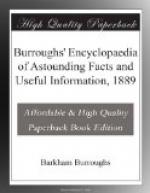* * * * *
[Illustration: MULTUM IN PARVO.]
MULTUM IN PARVO
HISTORY OF THE BIBLES OF THE WORLD.
The Bibles of the world are the koran of the Mohammedans, the tripitaka of the Buddhists, the five kings of the Chinese, the three vedas of the Hindoos, the zendavesta of the Parsees and the scriptures of the Christians. The koran, says the Chicago Times, is the most recent, dating from the seventh century after Christ. It is a compound of quotations from both the Old and the New Testaments and from the talmud. The tripitaka contain sublime morals and pure aspirations. Their author lived and died in the sixth century before Christ.
The sacred writings of the Chinese are called the five kings, the word “king” meaning web of cloth. From this it is presumed that they were originally written on five rolls of cloth. They contain wise sayings from the sages on the duties of life, but they can not be traced further back than the eleventh century before our era. The vedas are the most ancient books in the language of the Hindoos, but they do not, according to late commentators, antedate the twelfth before the Christian era. The zendaveata of the Parsees, next to our Bible, is reckoned among scholars as being the greatest and most learned of the sacred writings. Zoroaster, whose sayings it contains, lived and worked in the twelfth century before Christ. Moses lived and wrote the pentateuch 1,500 years before the birth of Jesus, therefore that portion of our Bible is at least 300 years older than the most ancient of other sacred writings. The eddas, a semi-sacred work of the Scandinavians, was first given to the world in the fourteen century A.D.
PRECIOUS STONES.
ARRANGED ACCORDING TO COLOR AND IN ORDER OF HARDINESS.
Limpid.—Diamond, Sapphire, Topaz, Rock-Crystal.
Blue.—Sapphire, Topaz,
Indicolite, Turquoise, Spinel, Aquamarine,
Kaynite.
Green.—Oriental Emerald,
Chrysoberyl, Amazon Stone, Malachite,
Emerald, Chrysoprase, Chrysolite.
Yellow.—Diamond, Topaz, Fire-Opal.
Red.—Sapphire-Ruby,
Spinel-Ruby, Rubellite, Garnet,
Brazilian-Topaz, Hyacinth, Carnelian.
Violet.—Oriental-Amethyst, Amethyst.
Black and Brown.—Diamond, Tourmaline, Hyacinth, Garnet.
HOW TO MEASURE CORN IN THE CRIB.
Rule: 1st. Measure the length, breadth and height of the crib inside the rail; multiply them together and divide by two, the result is the number of bushels of shelled corn.
2d. Level the corn so that it is of equal depth throughout, multiply the length, breath and depth together, and this product by four, and cut off one figure to the right of the product; the other will represent the number of bushels of shelled corn.




